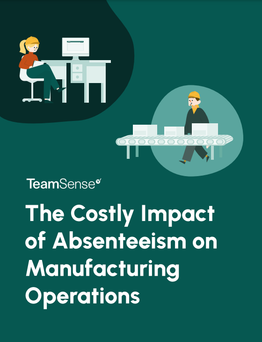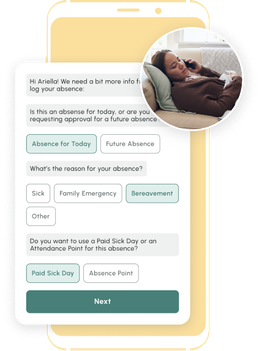Fix the root cause of No-Call No-Show with help from TeamSense
Labor planning is your secret weapon to keep things running smoothly. It’s about knowing exactly how many employees you need and when, so you’re never left scrambling. In sectors like retail, warehouses, and entertainment, having the right team at the right time is crucial. But let's be clear: It’s not just about filling open shift slots—it’s also about having a smooth operation that keeps everyone happy.
Fun fact: the average hourly wage for private-sector employees is $34.99 as of June 2024, according to the U.S. Bureau of Labor Statistics (FRED). That means if you’re overstaffed, you’re spending more than you need to. And if you’re understaffed, you’re most likely having to pay someone overtime to fill the shift last minute. In places of business like retail, warehouses, and entertainment, where hourly workers are key, getting labor planning right is crucial. Below, we take a look at labor planning as a whole and share some top strategies to help you nail it and keep your team smiling and your customers coming back.
Why Labor Planning Matters
Labor planning is similar to shift management but covers much more, including the process of forecasting and scheduling the right number of employees needed to meet the demands of your business. It’s crucial for industries that rely heavily on hourly employees, like retail, warehouses, and entertainment, because it ensures you have the right people in the right place at the right time.
Effective labor planning helps optimize workforce efficiency by aligning staff levels with business needs. This means you can handle peak times without being understaffed, which can lead to stressed employees and poor customer service. Conversely, it is effective workforce planning that helps you avoid overstaffing during slow periods, which can waste money and resources. The HR department plays a pivotal role in driving these labor planning initiatives, ensuring collaboration with senior leadership to align with broader organizational strategies and goals.
Labor planning helps control labor costs by reducing both overstaffing and understaffing. It ensures you’re not paying for more labor than you need, nor are you losing potential revenue due to a lack of staff. This balance is key to maintaining profitability and operational efficiency.
Moreover, good labor planning improves overall productivity for organizations. When employees are scheduled appropriately, they’re more likely to be engaged and satisfied with their work, leading to better performance and lower turnover rates. It also makes it easier for organizations to comply with labor laws, reducing the risk of legal issues and fines.

Common Challenges in Labor Planning
Labor planning can be a bit of a juggling act. From last-minute no-shows to figuring out just how many employees you need, to complying with all those labor laws, there are plenty of hurdles to clear when labor planning. Managing turnover as existing employees leave adds another layer of complexity. If you’ve ever felt like you’re playing whack-a-mole with your schedule, you’re not alone. In this section, we’ll chat about some of the most common headaches when it comes to labor planning. Understanding these bumps in the road can help you navigate around them, making your business run smoother and keeping your team happier. Let’s dig into the big ones.
Managing Seasonal Fluctuations
In industries like manufacturing, distribution, retail, and entertainment, seasonal fluctuations can throw a wrench in your labor and workforce planning process. Think about the holiday rush in retail or the busy summer months at theme parks – these are times when you need more hands on deck. The trick is to forecast these busy periods accurately and plan for them effectively.
Start by looking at your historical data. What were your staffing needs during the same period last year? Use this information to determine and predict future demands. You can also factor in upcoming events, promotions, or any external factors that might affect customer traffic.
Hiring temporary staff or offering overtime to your current employees are common strategies to handle these peak times. Temporary employees can play a crucial role in managing seasonal fluctuations by providing the flexibility needed to fill skill gaps and meet increased demand. But don’t forget about training your team to be flexible and adaptable. Cross-training employees so they can cover multiple roles can be a lifesaver during these busy periods. The goal is to be prepared without being caught off guard, ensuring smooth operations and happy customers.
Addressing Staffing Gaps
Labor shortages can be a real pain, and they often hit when you least expect it. Various factors like demographic changes, economic conditions, and even pandemics can cause labor and supply shortages, making it tough to keep your business running smoothly.
One way to tackle this is by investing in your current and future workforce too. Offer training and development opportunities to help employees grow within your company. This not only boosts their skills but also their loyalty to your business.
Partnering with staffing agencies can provide employers with a quick fix during critical shortages, giving you access to a pool of temporary workers. Additionally, offering competitive wages and benefits can make businesses attract and retain talent in a tight labor market.
Flexibility is key. Consider offering flexible work hours if feasible. Understanding workforce demand and addressing the root causes of labor shortages can help you develop a more resilient workforce strategy.
Compliance with Labor Laws
Navigating labor laws can feel like walking through a minefield, but it’s essential to get it right. Labor laws are there to protect workers, and failing to comply can lead to hefty fines and damage your company or organization's reputation.
Make sure you’re up-to-date with regulations on overtime pay, employee classification, minimum wage, and scheduling requirements. For instance, some regions have strict laws about how much notice you need to give employees about their schedules and jobs and how you handle last-minute changes.
Using labor management software can help you stay compliant. These tools can automatically flag potential violations and keep track of hours worked, ensuring you’re paying overtime correctly and giving employees their required breaks.
In short, keeping up with labor laws isn’t just about avoiding penalties – it’s about creating a fair and supportive workplace for your team. This not only keeps you on the right side of the law but also boosts employee morale and trust.

The Costly Impact of Absenteeism on Manufacturing Operations
Learn how chronic, unplanned absenteeism is a costly impediment to manufacturing productivity and efficiency, and how you can reduce absenteeism.
Strategies for Effective Labor Planning
So, now that we’ve talked about why labor planning is crucial and some of the common headaches that come with it, let’s get into the good stuff – how to do it right. Effective labor planning is all about making sure you have the right number of people, with the right skills, at the right times. It’s not rocket science, but it does require some smart strategies and tools. A well-developed strategic plan acts as a guiding framework for your labor planning efforts, ensuring alignment with overall business goals. In this section, we’ll break down some tried-and-true methods to help you streamline your labor planning process, save money, and keep your team running like a well-oiled machine.
Workforce Demand Forecasting
Workforce forecasting is like having a playbook for your staffing needs. It’s all about predicting when you’ll need more hands on deck and when you can scale back. By looking at historical data, sales trends, and external factors, you can make more accurate predictions about your labor needs. Understanding the composition of your current workforce is crucial for identifying gaps and making informed staffing decisions.
Start by diving into your historical data. Look at sales figures from the past year to spot patterns. For instance, if you run a retail store, you might see that sales spike during the holiday season. A warehouse might be busier at the start of each month when new stock arrives. These patterns give you a solid foundation for your forecasts.
Next, keep an eye on future needs and current sales trends. If you’re launching a new product or running a big promotion, you’ll probably need more staff to handle the extra workload.
Don’t forget about external factors. Local events, economic conditions, and even the weather can impact your staffing needs. For example, a theme park will likely need more staff during school holidays or on sunny weekends. By considering all these elements, you can create a labor plan that ensures you have the right number of employees when you need them most.
Scheduling Best Practices
Creating efficient and flexible schedules is key to effective labor planning. Start by understanding your operational demands and your employees’ availability. Use automated scheduling tools to help match staff availability with your business needs. These tools can save you a ton of time and reduce scheduling conflicts by automatically generating optimal schedules.
Consider your employees' preferences where possible. Happy employees are more productive and less likely to call out unexpectedly. Make sure your schedules comply with labor laws regarding breaks, overtime, and maximum working hours. Flexibility is also crucial – be ready to adjust schedules to handle unexpected changes, like last-minute absences or sudden increases in demand.
Training and Development
Ongoing training and development are essential to ensure your employees have the skills they need. Investing in your team's growth not only improves their productivity but also boosts morale and reduces overall turnover too. Regular training sessions can help your staff stay up-to-date with the latest best practices and technologies in your industry.
Encourage a culture of continuous learning by offering opportunities for advancement and professional development for existing employees. This could be in the form of workshops, online courses, or even cross-training for different roles within your organization. When employees see that you’re invested in their growth, they’re more likely to stay engaged and committed to your business, leading to a more skilled and reliable workforce.
Leveraging Technology for Labor Planning
Let’s face it – managing labor planning manually can be a nightmare. Thankfully, we live in a time where technology can take a lot of that stress off your plate. From automated scheduling to real-time attendance tracking, the right tech tools can make your life a whole lot easier. In this section, we’ll explore how leveraging technology can streamline your labor planning process, reduce errors, and help you make data-driven decisions. It’s all about working smarter, not harder, and giving you the tools to keep your business running smoothly without the constant headaches.

Automated Attendance Systems
Automated attendance systems are a game-changer for managing 'no call no show' incidents. These systems use technology to track employee attendance in real-time, ensuring that you always know who’s on the clock and who’s not. By setting up automated reminders, you can reduce the chances of employees forgetting their shifts. For example, employees can receive notifications via text or email about their upcoming shifts, helping to keep attendance consistent.
Real-time call off data is another huge benefit. It allows managers to see attendance data as it happens, making it easier to spot patterns and address issues quickly. If someone doesn’t show up, you can be alerted immediately and take steps to cover the shift without the usual last-minute scramble. This not only helps in maintaining productivity but also boosts employee accountability.
One effective solution in this space is TeamSense, which offers a robust automated attendance system. TeamSense provides real-time tracking and automated notifications to ensure everyone is on the same page. By integrating TeamSense, you can streamline your attendance management process, reduce no-shows, and keep your operations running smoothly.
Labor Management Systems (LMS)
Labor Management Systems (LMS) are powerful tools that help track labor costs, analyze productivity, and optimize workforce allocation. These systems provide detailed insights into how labor is being used across your business, helping you identify areas where you can improve efficiency.
For instance, popular LMS technologies like Kronos, ADP Workforce Now, and SAP SuccessFactors offer features such as time and attendance tracking, scheduling, and labor cost analysis. By using these tools, you can see exactly how much you’re spending on labor, which tasks are taking the most time, and where you might need to adjust your staffing levels.
LMS tools also help with compliance, ensuring that you’re adhering to labor laws and regulations regarding overtime and employee classification. By automating these critical processes, you reduce the risk of human error and make sure your labor practices are both fair and legal.
Predictive Analytics and AI
Predictive analytics and AI are revolutionizing labor planning. These technologies analyze historical data and current staffing trends to forecast future labor needs accurately. This means you can anticipate busy periods and slow times, and adjust your staffing levels accordingly.
For example, AI can predict demand and supply based on factors like past sales data, seasonality, and even weather patterns. This helps you avoid being understaffed during peak times or overstaffed during slow periods. Predictive analytics can also identify potential bottlenecks in your operations, allowing you to address them before they become major issues.
Tools and services like IBM Watson and Microsoft Azure AI offer advanced analytics capabilities that can be integrated into your labor planning process. By leveraging these technologies, you can make more informed decisions, optimize your workforce allocation, manage more and ultimately run a more efficient and cost-effective operation.

No one wants to talk to their boss or a 1-800 stranger to call off. Text changes everything - Reducing No Call No Shows.
Implementing Labor Planning Solutions
Alright, we’ve talked about why labor and workforce planning process really matters and some of the tools that can help. Now, let’s get into the nitty-gritty of putting these strategies into action. Implementing labor planning solutions can seem daunting, but with the right approach, you can make the transition smooth and effective. A well-structured workforce plan is crucial in this process, as it ensures that input from various stakeholders is considered and aligns with the organization's strategic goals. In this section, we’ll cover practical steps to get your labor planning solutions up and running, how to measure their impact, and real-world examples to guide you. It’s all about turning those plans into reality and seeing the benefits for yourself. Let’s dive in!
Steps for a Smooth Transition
Switching from manual to automated labor planning systems can seem like a big leap, but with a clear plan, it can be smooth and straightforward. Here’s a step-by-step guide to help you make the transition:
- Assess Your Needs: Start by evaluating your current labor planning process. Identify pain points and areas where automation can make the most impact. This could be reducing scheduling conflicts, improving attendance tracking, or ensuring compliance with labor laws.
- Choose the Right Tools: Research and select the labor planning software that best fits your needs. Look for features like automated scheduling, real-time attendance tracking, and integration with your existing systems. Solutions like TeamSense, Kronos, and ADP Workforce Now are good starting points.
- Plan the Rollout: Develop a detailed implementation plan. Decide on a timeline, assign responsibilities, and set clear goals for what you want to achieve. Make sure to communicate this plan to all stakeholders.
- Train Your Team: Employee training is crucial for a successful transition. Provide comprehensive training sessions to ensure everyone knows how to use the new system. Offer ongoing support and resources to help them get comfortable with the new tools.
- Integrate with Existing Systems: Ensure the new software integrates seamlessly with your current systems, like payroll and HR software. This will help streamline your processes and avoid any data discrepancies.
- Pilot the System: Before a full rollout, run a pilot program with a small group of users. This helps you identify any issues and make necessary adjustments before going live across the entire organization.
- Monitor and Adjust: Once the system is live, closely monitor its performance. Collect feedback from users and make adjustments as needed. Regularly review the system’s effectiveness and make improvements to optimize its use.
Measuring ROI and Benefits
Implementing tech solutions for labor planning is an investment, and it’s important to measure the return on that investment (ROI) to ensure it’s worth it. Here’s how to measure ROI and the benefits of your new system:
- Calculate Initial Costs: Start by calculating the initial costs of the new system. This includes software purchase or subscription fees, hardware costs (if any), and implementation expenses.
- Track Ongoing Costs: Include ongoing costs such as maintenance, support, and any additional training required.
- Measure Productivity Gains: One of the main benefits of automated labor planning is increased productivity. Track metrics like reduced scheduling conflicts, improved attendance rates, and more efficient use of employee time.
- Analyze Cost Savings: Compare your labor costs before and after implementation. Look for reductions in overtime expenses, lower turnover rates, and savings from reduced administrative time spent on manual scheduling.
- Evaluate Compliance Benefits: Automated systems help ensure compliance with labor laws, which can save you from potential fines and legal costs. Track any compliance-related savings.
- Employee Satisfaction: Survey your employees to gauge their satisfaction with the new system. Happier employees are often more productive and less likely to leave, which can reduce turnover costs.
- Review Overall Efficiency: Assess how the new system has improved overall operational efficiency. This could be through better forecasting, more accurate scheduling, or smoother daily operations.
By tracking these metrics, you can get a clear picture of the ROI and overall benefits of your labor planning tech solutions, ensuring they deliver the value you need for your business.
Case Study and Success Story
Ever wonder how other companies tackle the tricky task of labor planning? It’s one thing to talk about strategies and tools, but seeing them in action is where the real magic happens. In this section, we dive into a real-world example of how Assa Abloy nailed their labor planning, transforming potential chaos into streamlined operations.
Real-World Example of Labor Planning
Take Sargent Manufacturing, part of Assa Abloy, which used to grapple with an outdated absence reporting system that was all about manual phone calls and heaps of miscommunication. Imagine starting your shift only to realize you’re short-staffed because someone’s call to report an absence got lost in the shuffle. They switched gears and brought in TeamSense, a sleek automated attendance system that kicked those old problems to the curb. This tech allowed employees to text in their absences, clearing up confusion and letting managers adjust the workforce on the fly. The result? Shift starts became smoother, and the whole operation ran more efficiently without missing a beat.
Lessons Learned
The experience of Sargent Manufacturing offers valuable lessons for other businesses looking to implement labor planning solutions:
- Integration with Existing Systems: Successful implementation requires that the new technology integrates seamlessly with existing HR and payroll systems to ensure data consistency and reduce manual work.
- Employee Training and Buy-In: Change management is crucial. Sargent ensured that every employee understood how to use the new system by providing extensive training and even creating handy reference cards. This helped overcome resistance to the new technology.
- Early Problem Identification: By running a pilot test and gathering feedback, Sargent could identify and address issues early, smoothing the full rollout.
- Communication is Key: Keeping open lines of communication with all stakeholders, including the union, ensured that there were no surprises. This transparency helped in gaining buy-in from everyone involved, particularly in a unionized environment.
- Leveraging Technology for Immediate Gains: The ability to receive immediate updates on staffing changes allowed Sargent to dynamically adjust their labor deployment, minimizing the impact of absences on productivity.
By focusing on these key areas, companies can enhance their operational efficiency through effective labor planning and gain a vital competitive edge in their respective industries.

Boosting Efficiency: A 3PL Company Slashes Absenteeism by 39% with TeamSense
TeamSense changed the way this 3PL handled absenteeism, resulting in significant improvement in absenteeism rates, and can help your company too!
Final Thoughts on Labor Planning
Wrapping up, it's clear that strategic labor planning isn't just a piece of the productivity puzzle—it's a cornerstone of modern business operations. From the real-world success at Sargent Manufacturing to the general principles we've discussed, effective labor planning leverages technology to streamline operations, cut costs, and boost employee satisfaction.
Key Takeaways:
- Technology is a Game-Changer: Automated systems like TeamSense transform the chaos of manual processes into streamlined, efficient operations. Real-time updates and automated notifications ensure that shifts start smoothly, reducing the strain on both management and staff.
- Integration and Training are Essential: Seamlessly integrating new technologies with existing systems and ensuring thorough training are crucial for success. These steps prevent disruptions during the transition to automated solutions.
- Communication Keeps Things Smooth: Keeping all stakeholders informed, especially in environments with unions, ensures that everyone is on the same page, which facilitates smoother implementations and operations.
- Strategic Benefits: The strategic application of labor planning solutions not only improves day-to-day operations but also enhances long-term business resilience. Predictive analytics and real-time data help businesses adapt quickly to changing circumstances, maintaining efficiency regardless of external pressures.
The evolution of labor planning with technological advancements offers significant advantages. By adopting and adapting these innovations, businesses can ensure they not only keep pace with the market but set the pace, making their operations more resilient and responsive. As we've seen, when done right, the benefits of strategic labor planning touch every aspect of the business, from the shop floor to the boardroom.
About the Author

Jackie Jones, Employee Engagement & Attendance Specialist
Jackie Jones has over three years of experience helping HR teams improve employee morale, reduce absenteeism, and create happier, more engaged workplaces. With a strong background in employee relations and attendance management, she brings practical strategies and insights that support frontline teams and the HR professionals who lead them.


